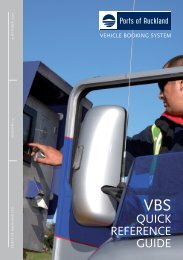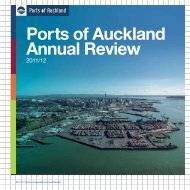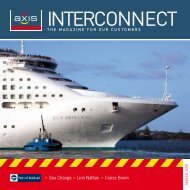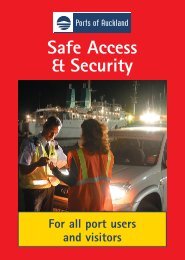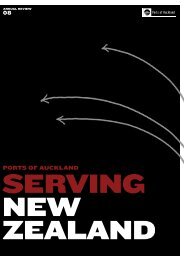Crane Rates Soaring > Top Class Lashing ... - Ports of Auckland
Crane Rates Soaring > Top Class Lashing ... - Ports of Auckland
Crane Rates Soaring > Top Class Lashing ... - Ports of Auckland
You also want an ePaper? Increase the reach of your titles
YUMPU automatically turns print PDFs into web optimized ePapers that Google loves.
LineS get A gOOd<br />
POrtS OF AUCkLA<br />
EVERy yEAR<br />
HuNdREdS Of SEA<br />
CONtAINERS ARE<br />
LOSt OVERBOARd<br />
OR dAmAGEd<br />
duRING tHE<br />
VOyAGE tHROuGH<br />
mOVEmENt.<br />
BESIdES tHE<br />
COSt Of tHE<br />
LOSS OR dAmAGE,<br />
CONtAINERS<br />
OVERBOARd OftEN<br />
REmAIN AfLOAt fOR<br />
WEEKS PRESENtING<br />
A SERIOuS<br />
COLLISION RISK.<br />
SEPTEMBER 2011<br />
In recent times the number <strong>of</strong> containers<br />
lost overboard has reduced considerably<br />
according to a recent report by the<br />
World Shipping Council (WSC) which<br />
estimates that from highs <strong>of</strong> 10,000 box<br />
slips <strong>of</strong>f ships per year, there are now<br />
less than 1,000 – perhaps as few as 700<br />
slips per year.<br />
This achievement wSC attributes to<br />
significant improvement in container lashing<br />
standards. And it is in this crucial yet low<br />
pr<strong>of</strong>ile area that <strong>Ports</strong> <strong>of</strong> <strong>Auckland</strong> has<br />
become a pacemaker in the lashing<br />
efficiency charge.<br />
<strong>Lashing</strong> is an integral part <strong>of</strong> the service<br />
that POAL provides its shipping line<br />
customers. In the stevedoring part <strong>of</strong> that<br />
service lashing would be rated by many as<br />
the most important element. That is because<br />
it is the lashing team that both initiates and<br />
completes the container exchange process.<br />
They therefore directly influence the time<br />
the ship is at the berth. Not only do the<br />
lashers influence the speed <strong>of</strong> the exchange,<br />
it is their efficient lashing techniques and<br />
processes that prevent lashing system failure,<br />
loss <strong>of</strong> cargo and decrease the risk<br />
<strong>of</strong> container damage due to movement<br />
during a voyage.<br />
<strong>Lashing</strong> is basically the process <strong>of</strong> securing<br />
containers together once they are loaded<br />
onboard ship and <strong>of</strong> releasing that security<br />
system on the ship’s arrival. Over time the<br />
process has been transformed in terms <strong>of</strong><br />
both safety and effective, efficient lashing<br />
equipment which today includes solid<br />
metal lashing bars that hold the containers<br />
together and twistlocks that secure<br />
containers ondeck.<br />
A major exchange at POAL will typically<br />
engage multiple cranes with six lashers<br />
working beneath each crane. There are in<br />
fact 200 lashers at <strong>Ports</strong> <strong>of</strong> <strong>Auckland</strong> most <strong>of</strong><br />
whom are fully trained to NZqA assessments<br />
standards in a lashing training programme<br />
introduced by POAL as a NZ ‘first’.<br />
POAL Senior Shift Manager Mike Kirwan says<br />
the high percentage <strong>of</strong> POAL’s stevedores<br />
who are lasher-trained reflects the High<br />
Priority status POAL gives to <strong>Lashing</strong>.<br />
“This is reflected in our unique training<br />
programme. Firstly it’s not carried out over<br />
an hour or two on the job onboard the ship.<br />
we put a lot <strong>of</strong> time into it: It’s a five day<br />
programme in a designated training area that<br />
enables practical but safe lasher technique<br />
demonstration and practice. The bonus is<br />
that while practice will invariably bring its





